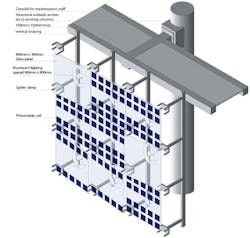Power Play
By Maureen Patterson
Can buildings showcase high-tech artistic media and environmental initiatives at the same time?
Yes. The two no longer need be mutually exclusive. The GreenPix Zero Energy Media Wall at Xicui entertainment complex in Beijing sustains itself and then some. Before its opening in June, the architect and engineer predicted the wall would generate as much energy in the day as it would need to power its LED theatrics at night. It has outperformed predictions, generating at least double the energy required.
As important to architect Simone Giostra is the significance of GreenPix as an artistic medium, challenging the notion that high-res is always best. In contrast to some outdoor displays that use a pixel every 10 millimeters, this one uses a pixel every 3 feet. An advertising billboard this is not: Marketers would not be welcome, but artists, come right in. "Too often media in architecture has been addressed like a television screen, like we would be sitting in your living room and watching for hours," says Giostra, founder of New York-based Simone Giostra & Partners Architects.
With GreenPix Giostra reduces the resolution to convey information to viewers - in his words, the project is "playing with the threshold of perception." He's already found that some artists need more pixelation than Xicui provides. Others thrive, blending the human form rhythmically across the surface. Colors dance. Forms collide. In the cloak of the nighttime sky the façade's 2,292 LED light points come alive over the 24,000-square-foot surface.
In the day, they stay silent, deferring to polycrystalline photovoltaic (PV) cells spread unevenly on specially formulated glass. "Most of the technology is in that space between the existing building and the outer surface of the glass. The glass is quite special," explains Steve Walker, associate director at Arup, whose London and Beijing offices did lighting design and façade engineering.
Two layers of tempered glass of about 8 millimeters each contain a series of interlayers that provide various degrees of transparency. The solar cells are laminated within the outer glass layer, which is also waterproof. Osram LEDs sit 2 feet behind the glass panels.
Finding the right balance of translucency was key. The glass could not block the light; instead, the light needed to illuminate the whole panel in a blurred effect. Arup professionals used sophisticated software simulations to anticipate the behavior of the light and the performance of the LEDs. In fact, designers conducted extensive testing and mock-ups to ensure performance at every level.
They also calculated the number of solar cells needed to power the LEDs. "The cells are a new generation of photovoltaics that actually is very efficient even without direct sun," Giostra explains. "Not only can you vary the size of the cells and the distance between cells, but now you can also laser-cut and perforate the cells so as to make them more transparent, and you can calibrate the amount of energy production surface of the cells to a very high degree of precision."
Glass panel PVs generally start at $50 per square foot, he says. He estimates the AV cost for this project at $350,000 - including wiring systems, the content management system, software, and LEDs.
Giostra originally talked about storing the energy captured by the PVs during the day to power the LEDs at night; the video wall would therefore perform differently on cloudy days than sunny days, mimicking the patterns of nature. Says Walker, "It became apparent that we would obtain a better match of PV capacity to lighting load using a grid-connected system."
Instead of feeding power to a battery, the PVs feed power to the grid - wires take DC voltage from the solar cells to an inverter, where it is converted to AC power, fed into the building's transformer, and to the city's power grid, the same power source the LEDs draw from at night. Walker says the energy yield from the PVs is monitored and can be used as a programmed response to the LED lighting system. The grid-connected system does not require batteries, which typically contain toxic materials and have a relatively short lifetime. Because of this system, the video wall performs the same at night regardless of the weather during the day.
To collect enough energy to compensate for the LEDs, the solar cells did not need to cover the entire surface of the wall. Certain areas of the building required visibility to the outside; others required neither visibility nor light of any kind. The density and pattern of solar cells varies for artistic effect, making the façade appear organic. Here is where GreenPix was able to mirror the variety of nature. "The façade is reflecting those weather conditions, the sky and the light, in different ways. It's an ever-changing visual experience," Giostra says.
Certain panels are tilted, also for aesthetic effect. Giostra originally intended for the panels to track the sun's rays but quickly dismissed the idea. That system would not be necessary for the high-performance PVs, and the building did not need increased ventilation. "It was just unreasonable to think that in addition to the LED and the photovoltaics you will possibly use another layer of technology," Giostra says.
If the system performs better than expected, why add complexity? The GreenPix team precisely and conservatively calculated the components they would need to achieve zero energy. They met their goal with power to spare. At the same time, they created a new medium for artistic expression.
Dynamic media facades and sustainability have not been partners in the past. Giostra and Arup found a way to combine the two and did it in a way that adds aesthetics to the discourse. They gave back both to the environment and to the people of Beijing. In the future, perhaps instead of self-sustaining façades, AV will be a power player in self-sustaining buildings.
Maureen Patterson is the former managing editor at ARCHI-TECH.
